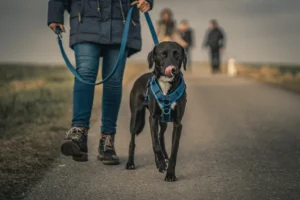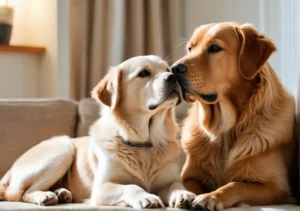We’ve all done it – engaged in a friendly bout of wrestling with our furry friends. But when those playful nibbles turn into aggressive bites, you may start wondering: why does my dog attack me when I play fight?
Hold on to your leash, because we’re about to dive into the dynamics of play fights and dog aggression. We’ll help you understand your canine pal’s behavior better and guide you on creating a safe, enjoyable playtime.

Play Fighting with Dogs: Fun or Fiasco?
Play fighting with dogs can be a fun and bonding experience. It’s a great way to stimulate your dog physically and mentally.
However, it’s a double-edged sword. Without proper boundaries, play fighting can quickly turn into a fiasco. Dogs, especially those that are larger or have high energy levels, can get overly excited and inadvertently cause injury.
For dogs, play fighting is an extension of their primal hunting instincts. The line between playing and actual aggression can sometimes blur.
Understanding this dynamic is key to ensuring your play fights remain fun and safe.
Why Does My Dog Get Aggressive?
Aggression during play fights can stem from a variety of reasons.
Dogs might misinterpret the play as a real threat, triggering their defense mechanisms. Your dog might also get overstimulated during play, which can escalate into aggression.
Sometimes, it may not even be aggression, but rather your dog’s play style. Some dogs play rougher than others, and what may seem like aggression is merely their way of having fun.
However, if your dog is showing clear signs of aggression – such as baring teeth, growling aggressively, or attacking without any play signals, it’s crucial to address the behavior immediately. Remember, understanding your dog’s body language is key to determining if their behavior is playful or aggressive.
Stay with us as we delve further into distinguishing between play and aggression and provide tips on how to keep playtime safe and enjoyable for both you and your furry friend.
Does My Dog Understand Play vs Fight?
Absolutely, dogs are quite adept at understanding the difference between play and a real fight.
A crucial part of this understanding comes from socialization. Dogs learn to differentiate between play and aggression through interactions with other dogs, particularly during their early puppyhood.
During play, dogs exhibit various body language signals to communicate their intentions. The “play bow,” where a dog lowers its front legs while keeping its rear end up, is a universal doggy signal for “I want to play, not fight.”

Canines may also display relaxed, open-mouthed “play faces” and engage in exaggerated, bouncy movements.
However, if your dog didn’t have enough social interaction as a puppy or had negative experiences, they might have difficulty distinguishing play from real fights. In such cases, a behaviorist or professional dog trainer can help reinforce these distinctions and promote healthy play habits.
When Does Play Turn into Aggression?
The transition from play to aggression can be subtle, and sometimes, it might happen without any apparent reason. However, there are usually some tell-tale signs that a dog’s playful attitude is shifting towards aggression.
One common sign is an escalation in intensity. If your dog’s movements become quicker, rougher, and more frantic, they may be nearing the edge of aggression.
Similarly, changes in vocalizations can indicate a shift. Playful growls are generally low and rumbling, but aggressive growls are usually higher pitched and sound more serious.
Other signs include fixed, intense stares, stiff body language, and raised hackles. If you notice these signs, it’s best to immediately pause play to prevent the situation from escalating.
Remember, safe play is about respect and communication. Set boundaries and learn to read your dog’s signals to ensure playtime is a fun bonding experience. It’s always best to err on the side of caution. If in doubt, consult with a professional dog trainer or a behaviorist to guide you through the process.
How to Avoid Aggressive Triggers When Playing
From my years of experience with my own dogs, such as Charlie, an energetic and playful Golden Retriever, I’ve learned a few useful tips.
Firstly, it’s vital to recognize your dog’s signals and triggers. For instance, Charlie tends to get overly excited with vigorous tug-of-war games, which can lead to nipping and aggressive behavior. So, we’ve learned to limit these types of games and focus on less intense ones like fetch or hide and seek.
Try to keep play sessions short and sweet. Long playtimes can lead to over-excitement or exhaustion, potentially triggering aggression. Be observant of your dog’s body language and know when it’s time to end the play session.
Also, remember the importance of training. Incorporate basic commands like “sit,” “stay,” or “leave it” into your playtimes. These can help keep the play under control and prevent it from escalating into aggression.
Lastly, avoid physical punishment or scolding as this might confuse your dog and contribute to anxiety or aggression. Positive reinforcement is a far better approach. Always reward your dog for good behavior and slowly they will start to understand what is acceptable and what is not.
FAQs
How to teach my dog the difference between play and real fighting?
Start by teaching bite inhibition during puppyhood. This helps them understand the difference between a friendly nibble and a hurtful bite. Also, use clear, consistent signals during playtime. A good example is the “play bow” to signify that it’s playtime.
What signs to watch for to know if my dog is getting too aggressive?
Watch out for stiff body language, prolonged eye contact, raised hackles, and high-pitched growls. If your dog displays any of these signs, it’s best to pause the play session and allow them to calm down before resuming play.
Why does my dog growl when we play fight?
Play growling is a common way for dogs to express enjoyment. However, if the growl sounds more intense or is accompanied by aggressive body language, it may be a sign of discomfort or aggression.
Is it possible that my dog doesn’t enjoy play fighting?
Yes, dogs are unique and some might not enjoy play fighting. If your dog seems uncomfortable or disengages often, they might prefer calmer activities. It’s important to respect their preferences to ensure a positive bond.
Alex, a passionate animal lover, has experience in training and understanding animal behavior. As a proud pet parent to two dogs and three cats, he founded AnimalReport.net to share insights from animal experts and expand his knowledge of the animal kingdom.




